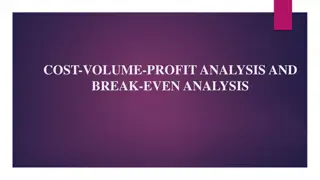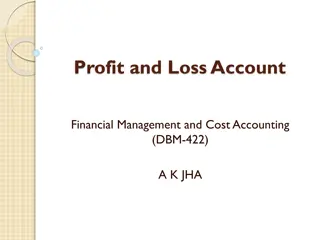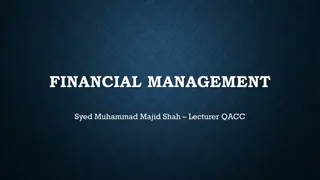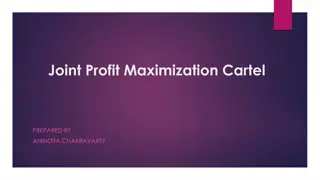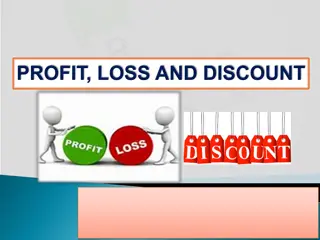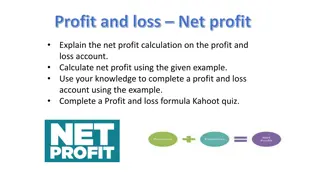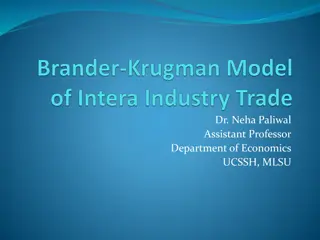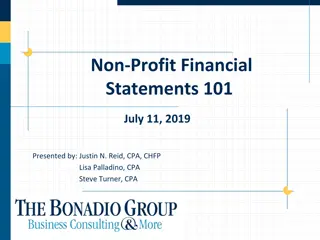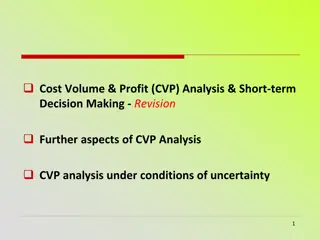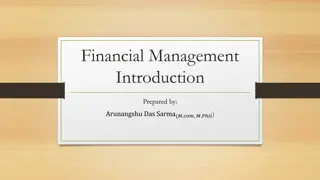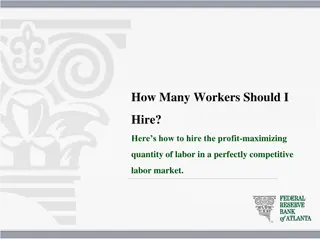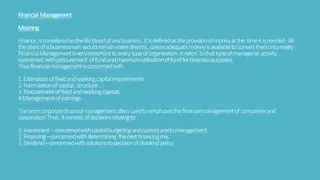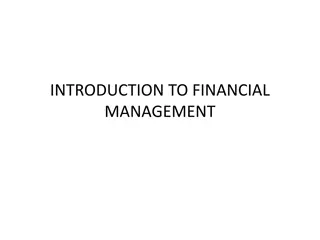The Costs of Production and Profit Maximization
Explore the concept of costs of production in business, distinguishing between explicit and implicit costs. Learn the difference between economic profit and accounting profit, and understand the importance of considering all costs in maximizing profit. Dive into examples and the production function to grasp these fundamental economic principles.
Download Presentation

Please find below an Image/Link to download the presentation.
The content on the website is provided AS IS for your information and personal use only. It may not be sold, licensed, or shared on other websites without obtaining consent from the author.If you encounter any issues during the download, it is possible that the publisher has removed the file from their server.
You are allowed to download the files provided on this website for personal or commercial use, subject to the condition that they are used lawfully. All files are the property of their respective owners.
The content on the website is provided AS IS for your information and personal use only. It may not be sold, licensed, or shared on other websites without obtaining consent from the author.
E N D
Presentation Transcript
13 C H A P T E R THE COSTS OF PRODUCTION
Total Revenue, Total Cost, Profit We assume that the firm s goal is to maximize profit. Profit = Total revenue Total cost the amount a firm receives from the sale of its output the market value of the inputs a firm uses in production THE COSTS OF PRODUCTION
Costs: Explicit vs. Implicit Explicit costs require an outlay of money, e.g., paying wages to workers. Implicit costs do not require a cash outlay, e.g., the opportunity cost of the owner s time. Remember one of the Ten Principles: The cost of something is what you give up to get it. This is true whether the costs are implicit or explicit. Both matter for firms decisions. THE COSTS OF PRODUCTION
Explicit vs. Implicit Costs: An Example You need $100,000 to start your business. The interest rate is 5%. Case 1: borrow $100,000 explicit cost = $5000 interest on loan Case 2: use $40,000 of your savings, borrow the other $60,000 explicit cost = $3000 (5%) interest on the loan implicit cost = $2000 (5%) foregone interest you could have earned on your $40,000. In both cases, total (exp+ imp) costs are $5000. THE COSTS OF PRODUCTION
Economic Profit vs. Accounting Profit Accounting profit = total revenue minus total explicit costs Economic profit = total revenue minus total costs (including explicit and implicit costs) Accounting profit ignores implicit costs, so it s higher than economic profit. THE COSTS OF PRODUCTION
The Production Function A production function shows the relationship between the quantity of inputs used to produce a good and the quantity of output of that good. It can be represented by a table, equation, or graph. Example 1: Farmer Jack grows wheat. He has 5 acres of land. He can hire as many workers as he wants. THE COSTS OF PRODUCTION
Example 1: Farmer Jacks Production Function L Q 3,000 (no. of workers) (bushels of wheat) 2,500 Quantity of output 0 0 2,000 1 1000 1,500 2 1800 1,000 3 2400 500 4 2800 0 0 1 2 3 4 5 5 3000 No. of workers THE COSTS OF PRODUCTION
Marginal Product If Jack hires one more worker, his output rises by the marginal product of labor. The marginal product of any input is the increase in output arising from an additional unit of that input, holding all other inputs constant. Notation: (delta) = change in Examples: Q = change in output, L = change in labor Marginal product of labor (MPL) = Q L THE COSTS OF PRODUCTION
EXAMPLE 1: Total & Marginal Product L Q (no. of workers) (bushels of wheat) MPL 0 0 1000 Q = 1000 L = 1 1 1000 800 Q = 800 L = 1 2 1800 600 L = 1 Q = 600 3 2400 Q = 400 400 L = 1 4 2800 200 L = 1 Q = 200 5 3000 THE COSTS OF PRODUCTION
EXAMPLE 1: MPL = Slope of Prod Function L Q MPL equals the slope of the production function. 3,000 MPL (no. of workers) (bushels of wheat) 2,500 Quantity of output 0 0 2,000 Notice that MPL diminishes as L increases. 1,000 1000 1 1000 1,500 800 2 1800 This explains why the production function gets flatter as L increases. 0 1 No. of workers 600 3 2400 500 400 4 2800 0 200 2 3 4 5 5 3000 THE COSTS OF PRODUCTION
Why MPL Is Important Recall one of the Ten Principles: Rational people think at the margin. When Farmer Jack hires an extra worker, his costs rise by the wage he pays the worker his output rises by MPL Comparing them helps Jack decide whether he would benefit from hiring the worker. THE COSTS OF PRODUCTION
Why MPL Diminishes Farmer Jack s output rises by a smaller and smaller amount for each additional worker. Why? As Jack adds workers, the average worker has less land to work with and will be less productive. In general, MPL diminishes as L rises whether the fixed input is land or capital (equipment, machines, etc.). Diminishing marginal product: the marginal product of an input declines as the quantity of the input increases (other things equal) THE COSTS OF PRODUCTION
EXAMPLE 1: Farmer Jacks Costs Farmer Jack must pay $1000 per month for the land, regardless of how much wheat he grows. The market wage for a farm worker is $2000 per month. So Farmer Jack s costs are related to how much wheat he produces . THE COSTS OF PRODUCTION
EXAMPLE 1: Farmer Jacks Costs L Q Cost of land Cost of labor Total Cost (no. of workers) (bushels of wheat) 0 0 $1,000 $0 $1,000 1 1000 $1,000 $2,000 $3,000 2 1800 $1,000 $4,000 $5,000 3 2400 $1,000 $6,000 $7,000 4 2800 $1,000 $8,000 $9,000 5 3000 $1,000 $10,000 $11,000 THE COSTS OF PRODUCTION
EXAMPLE 1: Farmer Jacks Total Cost Curve $12,000 Q Total Cost (bushels of wheat) $10,000 $8,000 0 $1,000 Total cost $6,000 1000 $3,000 $4,000 1800 $5,000 $2,000 2400 $7,000 $0 2800 $9,000 0 1000 Quantity of wheat 2000 3000 3000 $11,000 THE COSTS OF PRODUCTION
Marginal Cost Marginal Cost (MC) is the increase in Total Cost from producing one more unit: TC Q MC = THE COSTS OF PRODUCTION
EXAMPLE 1: Total and Marginal Cost Q Total Cost Marginal Cost (MC) (bushels of wheat) 0 $1,000 $2.00 TC = $2000 Q = 1000 1000 $3,000 $2.50 TC = $2000 Q = 800 1800 $5,000 $3.33 TC = $2000 Q = 600 2400 $7,000 $5.00 TC = $2000 Q = 400 2800 $9,000 $10.00 TC = $2000 Q = 200 3000 $11,000 THE COSTS OF PRODUCTION
EXAMPLE 1: The Marginal Cost Curve $12 Q (bushels of wheat) TC MC MC usually rises as Q rises, as in this example. $10 Marginal Cost ($) $8 0 $1,000 $2.00 $6 1000 $3,000 $2.50 $4 1800 $5,000 $3.33 2400 $7,000 $2 $5.00 2800 $9,000 $0 $10.00 0 1,000 2,000 3,000 3000 $11,000 Q THE COSTS OF PRODUCTION
Why MC Is Important Farmer Jack is rational and wants to maximize his profit. To increase profit, should he produce more or less wheat? To find the answer, Farmer Jack needs to think at the margin. If the cost of additional wheat (MC) is less than the revenue he would get from selling it, then Jack s profits rise if he produces more. THE COSTS OF PRODUCTION
Fixed and Variable Costs Fixed costs (FC) do not vary with the quantity of output produced. For Farmer Jack, FC = $1000 for his land Other examples: cost of equipment, loan payments, rent Variable costs (VC) vary with the quantity produced. For Farmer Jack, VC = wages he pays workers Other example: cost of materials Total cost (TC) = FC + VC THE COSTS OF PRODUCTION
EXAMPLE 2: Costs $800 FC VC TC Q FC VC TC $700 0 $100 $0 $100 $600 1 100 70 170 $500 Costs 2 100 120 220 $400 3 100 160 260 $300 4 100 210 310 $200 5 100 280 380 $100 6 100 380 480 $0 7 100 520 620 0 1 2 3 4 5 6 7 Q THE COSTS OF PRODUCTION
EXAMPLE 2: Marginal Cost Recall, Marginal Cost (MC) is the change in total cost from producing one more unit: $175 $200 Q TC MC 0 $100 $70 $150 1 170 TC Q 50 $125 MC = 2 220 Costs 40 $100 Usually, MC rises as Q rises, due to diminishing marginal product. $50 3 260 50 $75 4 310 70 Sometimes (as here), MC falls before rising. $25 5 380 100 6 480 (In other examples, MC may be constant.) 0 1 140 $0 7 620 2 3 4 5 6 7 Q
EXAMPLE 2: Average Fixed Cost Average fixed cost (AFC) is fixed cost divided by the quantity of output: $150 Q FC AFC $200 $175 0 $100 n/a 1 100 $100 AFC = FC/Q $125 Costs 2 100 50 $100 3 100 33.33 Notice that AFC falls as Q rises: The firm is spreading its fixed costs over a larger and larger number of units. $0 0 1 2 $75 4 100 25 $50 5 100 20 $25 6 100 16.67 7 100 14.29 3 4 5 6 7 Q THE COSTS OF PRODUCTION
EXAMPLE 2: Average Variable Cost Average variable cost (AVC) is variable cost divided by the quantity of output: $150 Q VC AVC $200 $175 0 $0 n/a 1 70 $70 AVC = VC/Q $125 Costs 2 120 60 $100 3 160 53.33 As Q rises, AVC may fall initially. In most cases, AVC will eventually rise as output rises. $25 $75 4 210 52.50 $50 5 280 56.00 6 380 63.33 $0 0 1 2 3 4 5 6 7 7 520 74.29 Q THE COSTS OF PRODUCTION
EXAMPLE 2: Average Total Cost Average total cost (ATC) equals total cost divided by the quantity of output: Q TC ATC AFC AVC 0 $100 n/a n/a n/a 1 170 $170 $100 $70 2 220 110 50 60 ATC = TC/Q 3 260 86.67 33.33 53.33 Also, 4 310 77.50 25 52.50 ATC = AFC + AVC 5 380 76 20 56.00 6 480 80 16.67 63.33 7 620 88.57 14.29 74.29 THE COSTS OF PRODUCTION
EXAMPLE 2: Average Total Cost Q TC ATC $200 Usually, as in this example, the ATC curve is U-shaped. $150 $175 0 $100 n/a 1 170 $170 $125 Costs 2 220 110 $100 3 260 86.67 $75 4 310 77.50 $50 5 380 76 $25 6 480 80 $0 0 1 2 3 4 5 6 7 7 620 88.57 Q THE COSTS OF PRODUCTION
EXAMPLE 2:The Various Cost Curves Together $200 $175 $150 ATC $125 AVC Costs $100 AFC MC $75 $50 $25 $0 0 1 2 3 4 5 6 7 Q THE COSTS OF PRODUCTION
EXAMPLE 2: Why ATC Is Usually U-Shaped As Q rises: $200 Initially, falling AFC pulls ATC down. $175 $150 $125 Costs Eventually, rising AVC pulls ATC up. $100 $75 $50 Efficient scale: The quantity that minimizes ATC. $25 $0 0 1 2 3 4 5 6 7 Q THE COSTS OF PRODUCTION
EXAMPLE 2: ATC and MC When MC < ATC, ATC is falling. ATC MC $200 $175 When MC > ATC, ATC is rising. $150 $125 Costs The MC curve crosses the ATC curve at the ATCcurve s minimum. $100 $75 $50 $25 $0 0 1 2 3 4 5 6 7 Q THE COSTS OF PRODUCTION
Costs in the Short Run & Long Run Short run: Some inputs are fixed (e.g., factories, land). The costs of these inputs are FC. Long run: All inputs are variable (e.g., firms can build more factories, or sell existing ones). In the long run, ATC at any Q is cost per unit using the most efficient mix of inputs for that Q (e.g., the factory size with the lowest ATC). THE COSTS OF PRODUCTION
EXAMPLE 3: LRATC with 3 factory Sizes Avg Total Cost Firm can choose from 3 factory sizes: S, M, L. ATCMATCL ATCS Each size has its own SRATC curve. The firm can change to a different factory size in the long run, but not in the short run. Q THE COSTS OF PRODUCTION
EXAMPLE 3: LRATC with 3 factory Sizes Avg Total Cost To produce less than QA, firm will choose size S in the long run. To produce between QA and QB, firm will choose size M in the long run. To produce more than QB, firm will choose size L in the long run. ATCMATCL ATCS LRATC Q QA QB THE COSTS OF PRODUCTION
A Typical LRATC Curve In the real world, factories come in many sizes, each with its own SRATC curve. ATC LRATC So a typical LRATC curve looks like this: Q THE COSTS OF PRODUCTION
How ATC Changes as the Scale of Production Changes Economies of scale: ATC falls as Q increases. ATC LRATC Constant returns to scale: ATC stays the same as Q increases. Diseconomies of scale: ATC rises as Q increases. Q THE COSTS OF PRODUCTION
How ATC Changes as the Scale of Production Changes Economies of scale occur when increasing production allows greater specialization: workers more efficient when focusing on a narrow task. More common when Q is low. Diseconomies of scale are due to coordination problems in large organizations. E.g., management becomes stretched, can t control costs. More common when Q is high. THE COSTS OF PRODUCTION
CONCLUSION Costs are critically important to many business decisions, including production, pricing, and hiring. This chapter has introduced the various cost concepts. The following chapters will show how firms use these concepts to maximize profits in various market structures. THE COSTS OF PRODUCTION




